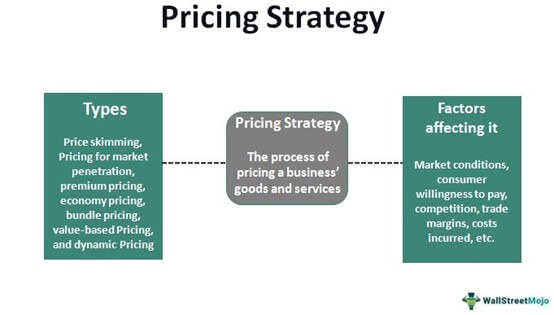Comprehending Consumer Actions and Its Effect On Your Pricing Strategy
Comprehending Consumer Actions and Its Effect On Your Pricing Strategy
Blog Article

Master Effective Prices Techniques to Take Full Advantage Of Earnings
In the ever-evolving landscape of business, understanding efficient prices methods is essential for businesses intending to make the most of earnings. A nuanced understanding of pricing psychology can considerably affect client actions and buying choices.
Understanding Prices Psychology
Comprehending pricing psychology is critical for organizations aiming to optimize their pricing approaches. This area analyzes how consumers regard rates and just how these perceptions influence their purchasing choices. Key principles in rates psychology consist of the anchoring result, where the initial price presented works as a recommendation factor for customers, and the concept of cost sensitivity, which differs among various consumer sectors.
Additionally, services can take advantage of the notion of viewed value, where the regarded benefits of a service or product can warrant a greater price point. As an example, premium pricing can create an aura of exclusivity, bring in consumers that associate higher costs with superior quality. On the other hand, psychological prices, such as establishing a rate at $9.99 rather than $10, can significantly influence customer behavior by making prices appear much more appealing.
In addition, scarcity and necessity can boost the viewed value of products, prompting quicker investing in decisions. Recognizing these mental triggers allows organizations to create rates approaches that not just drive sales yet likewise foster client loyalty. Thus, grasping prices psychology is necessary for efficient rates approach formulation, bring about boosted productivity and market positioning.
Applying Value-Based Rates

Next off, sector your consumers based on their willingness to pay and the worth they view. By doing so, you can tailor offerings and pricing strategies to align with different segments.
Continually keep an eye on market problems and consumer comments to fine-tune your prices technique over time. By executing value-based rates, companies can improve profitability while promoting lasting consumer commitment.
Discovering Dynamic Prices Designs
In today's swiftly transforming market landscape, dynamic pricing versions have actually become an effective method for companies looking for to optimize earnings and react to variations sought after. These versions allow business to adjust their prices in real-time based upon different factors such as consumer behavior, market trends, and stock degrees. By leveraging data analytics and algorithms, services can identify optimum pricing factors that take full advantage of sales while continuing to be competitive.
Dynamic prices can take various forms, including time-based prices, where rates rise and fall based on time of day or period, and demand-based prices, which readjusts prices according to current consumer need. This adaptability not just boosts success yet likewise boosts consumer contentment by using costs that reflect real-time market problems.
Carrying out vibrant pricing requires a robust technical framework and a deep understanding of customer sectors. Clear interaction regarding pricing changes can help mitigate consumer frustration and foster count on, ultimately leading to sustained earnings in a competitive industry.
Studying Rival Pricing
Keeping an eye on competitor pricing is necessary for businesses intending to keep an affordable side in their respective markets. By examining competitors' prices techniques, companies can determine market fads, understand consumer choices, and change their rates appropriately. This evaluation entails event information on rivals' prices, advertising approaches, and item offerings to educate prices choices.
To effectively analyze competitor rates, services need to site web utilize different devices and techniques, such as price tracking software program, market research study reports, and consumer responses. This information can expose how rivals place their services and products, allowing companies to differentiate their offerings or take on similar techniques to continue to be pertinent.
Additionally, it is essential to categorize competitors right into indirect and direct competitors. Straight competitors supply similar products or solutions, while indirect competitors may meet the very same customer requirement with various services. Understanding the nuances between these groups will certainly enable businesses to tailor their rates strategies more effectively.
Ultimately, continuous competitor prices evaluation is crucial for making enlightened rates choices. It allows companies to stay nimble in feedback to market shifts, ensuring they can confiscate chances and minimize risks related to prices techniques.
Examining Prices Efficiency
Comprehending exactly how competitor rates affects market dynamics results in an all-natural concentrate on assessing prices efficiency within one's own organization. This examination is essential for identifying areas of strength and possibilities for enhancement, eventually boosting productivity.

Additionally, performing regular rates audits can expose discrepancies in between anticipated and real performance. This includes comparing rates data throughout various segments and networks to recognize differences and identify fads. Moreover, integrating consumer comments can supply insights into regarded worth versus real prices, making sure positioning with market assumptions.
Lastly, leveraging data analytics devices can facilitate deeper insights into rates efficiency, making it possible for businesses to make data-driven adjustments (Pricing Strategy). By continually reviewing prices performance, organizations can go to the website adjust to market changes and maximize their approaches, ensuring continual productivity in an affordable landscape
Final Thought
By leveraging rates psychology, organizations can boost perceived worth and tailor pricing to diverse client sectors. The fostering of dynamic and value-based prices designs helps with real-time changes image source based on demand and consumer readiness to pay.
Understanding pricing psychology is important for organizations intending to maximize their prices techniques. Understanding these psychological triggers allows services to create rates approaches that not just drive sales however also foster client commitment. Thus, grasping pricing psychology is necessary for effective rates approach formula, leading to enhanced productivity and market positioning.
By evaluating rivals' pricing techniques, firms can recognize market patterns, recognize consumer choices, and readjust their rates as necessary. By leveraging rates psychology, organizations can boost viewed worth and tailor prices to varied consumer sectors.
Report this page